The best USB headset for your computer
Consider a headset like this for both the call quality and comfortable design.

By Ray Aguilera and Daniel Varghese
This post was done in partnership with Wirecutter. When readers choose to buy Wirecutter's independently chosen editorial picks, Wirecutter and Engadget may earn affiliate commission. Read the full guide to USB headset for your computer.
After putting in more than 50 hours of research and testing 17 different headsets, we've identified the Jabra Evolve 40 as our pick for the best USB headset for the office. It has the best sound quality—thanks to an excellent microphone and good headphones—of all the models we tested, and it's comfortable enough to wear for a full workday filled with long conference calls due to soft, well-padded earpieces that don't put pressure on your ears.
In our tests, calls we made sounded crisp and easy to understand to the people on the other end, and we could hear other people clearly. Though the boom mic is a little tricky to position, once placed correctly it picks up very little breathing and keeps voices sounding clear. The Evolve 40's passive noise-cancelling abilities let you focus on the call instead of the sounds around you, and the mic filters out most background noise. When you don't want to be heard, the easy-to-use mute controls work exactly as they should.
Microsoft's LifeChat LX-6000 was a previous top pick and runner-up and is still a good headset. Its headphones produce full sound that especially shines when listening to music, and the quality of its microphone is only a little worse than that of our main pick. But due to its headband design and small ear pads, the LX-6000 isn't very comfortable for long periods of use. If you don't need to wear a headset all day and make calls only occasionally, the LifeChat is a good way to save some money compared to the Jabra.
Why you should trust us
Ray Aguilera, who wrote the original version of this guide, has been reviewing and writing about consumer gadgets since 2007. He previously worked as Reviews Editor at Mac|Life, where one of his major beats was audio products, and he has continued to write about audio for a range of publications.
Daniel Varghese, who wrote the latest update, has used many different kinds of microphone and headphone configurations in amateur and professional capacities as a college radio DJ, podcast producer, and musician.
For each version of this guide, we spent several hours each week using phone and meeting software like Skype and Zoom to collaborate remotely with colleagues—a process that is improved by a good-sounding, reliable headset.
While researching this guide, Ray interviewed Forrest Guest, an indirect tax automation implementation consultant with Thomson Reuters, who spends "all day in conference calls. Some are pretty short and some are several-hour marathons." His perspective as a heavy user helped shape the criteria we looked for in choosing headsets and how we evaluated their performance.
Who should buy this
Pretty much everyone already has a headset, whether it's the earbuds that came with your phone or wireless headphones that you bought as an upgrade. As long as your headphones have a microphone, they'll work when you're making calls on your computer. So why spend the extra money for a USB headset designed specifically for such calls?
The main reasons come down to improved sound quality—both incoming and outgoing—and comfort. If you're using a headset for more than the occasional call, or for more than 20 minutes or so at a time, having one that's comfortable to wear means you can focus on your call instead of constantly being distracted by your headset—possibly to the point of actual pain.
The microphone on a good headset will be much better than a built-in mic, so callers will be able to hear you more clearly. You should also consider upgrading if you work in a noisy office and your current headset doesn't offer noise cancellation so you can hear better over ambient noise; similarly, a headset with a microphone that filters out background noise will make your calls clearer and more professional-sounding to people on the other end.
Conveniences like inline volume and mute controls make it easier to adjust call volume on the fly and let you quickly mute your microphone if you need to talk to someone who isn't on your call, though if you don't think you'd get much use out of these controls and don't want to deal with cords, you might prefer our wireless office headset recommendations. For a significantly higher price, you'll get the comfort and sound quality of our wired recommendations in a headset you can wear as you pace around your office or home.
(There's nothing about USB audio that makes it inherently better than what you'd get from an analog headset that uses traditional headphone/microphone jacks. USB headsets were initially introduced because few computers supported audio input and output from a single 3.5 mm port—you needed separate headphone and microphone jacks. Though this issue feels almost alien in a world full of wireless and Bluetooth options, a great wired USB headset still provides an elegant, one-connector solution—and one that doesn't introduce potential new issues.)
How we picked
Because few editorial reviews of USB headsets exist, we relied on our expert interviews and user reviews to hone our list of characteristics that all good USB headsets should have:
Comfort: A USB headset should be pleasant to wear for extended periods. This means that it should have an adjustable headband (so that it doesn't squeeze your head too hard) and ear pads that don't feel too scratchy. Ideally, the headset should be light enough that you can comfortably wear it for an entire workday.
Microphone quality: The primary purpose of a USB headset is to improve the clarity of your voice during calls compared to your computer's built-in mic. You don't want to sound too distant or sunken or too loud and bright; either can make you hard to understand. The best headsets pick up and transmit your voice clearly (usually by positioning the microphone at the end of an easily adjustable boom) without transmitting the sounds of normal breathing.
Speaker quality: Nearly as important as microphone quality is that the headset improves your ability to comprehend what is being said by others during a call or what you choose to listen to when off a call. We did not expect USB headsets to compete with the audio quality of standalone headphones three times their price, but since calls conducted over Wi-Fi or cellular signals tend to have more noise and audio issues than calls over physical lines, it's imperative that the headphones on your USB headset do not make the sound coming in even worse.
Inline controls: We considered only models with an inline controller on the cord with at least a mute button and volume controls. Those controls should be large enough to use easily and arranged logically, and any buttons that toggle a setting such as a mute button should provide some sort of visual cue when engaged. Additional controls to activate calls or a busy-ness indicator were a bonus, considering that those types of buttons typically require specific third-party call software.
Mute feedback: Knowing when and if you're muted is vital when you're on calls with clients or coworkers. Some headsets provide audible feedback in your headset whenever you hit the mute button by playing either ascending or descending chimes or a vocal recording that says "mute on" or "mute off." Since this is an addition to the visual feedback we required, we considered audible feedback to be a cherry on top.
Based on these criteria, we tested 11 headsets for the initial version of this guide. For our 2018 update, we found six new models—the Jabra Evolve 40, the Jabra Biz 1500, the Sennheiser SC 75, and the Plantronics Blackwire 5200—which we tested against our previous runner-up pick, the Microsoft's LifeChat LX-6000.
How we tested
Before conducting real-world tests, we used the meeting software Zoom to record ourselves speaking with each headset in a quiet room to establish baseline expectations for how each microphone would perform. Since each of the headsets recorded audio that was at least clear enough to understand in this controlled environment, we proceeded to wear each for at least one day to see how well it would fit into a typical 8-hour workday that includes a few conference calls.
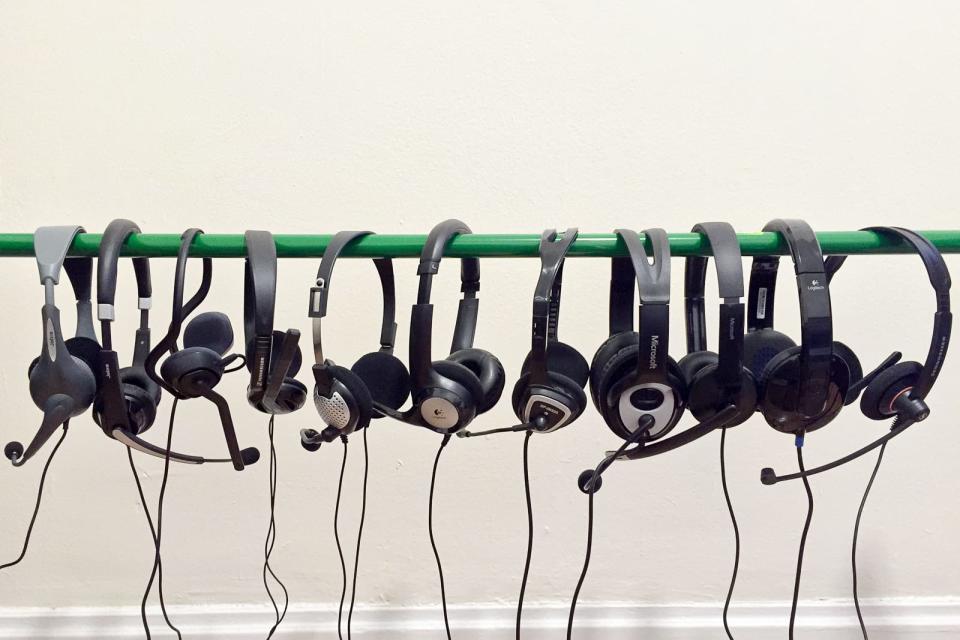
As we wore each of the headsets during work days, we focused largely on comfort. Daniel, who wears glasses, was particularly attuned to whether the headset felt like it was pinching his head too tightly, but we also evaluated the general headband comfort and whether or not the fabric on the ear pads was too scratchy. This allowed us to quickly eliminate headsets like the Jabra Biz 1500 which were very uncomfortable.
During video calls with coworkers, we solicited feedback about mic quality, and we noted whether anyone asked us to repeat ourselves; we also tested the inline mute and volume controls. Doing so allowed us to dismiss headsets like the Plantronics Blackwire 5200 because of poor mic performance. When we were not on a call or meeting, we listened to a rotation of music from several genres, as well as stand-up comedy, to assess the general quality of the headphone components.
Our pick: Jabra Evolve 40
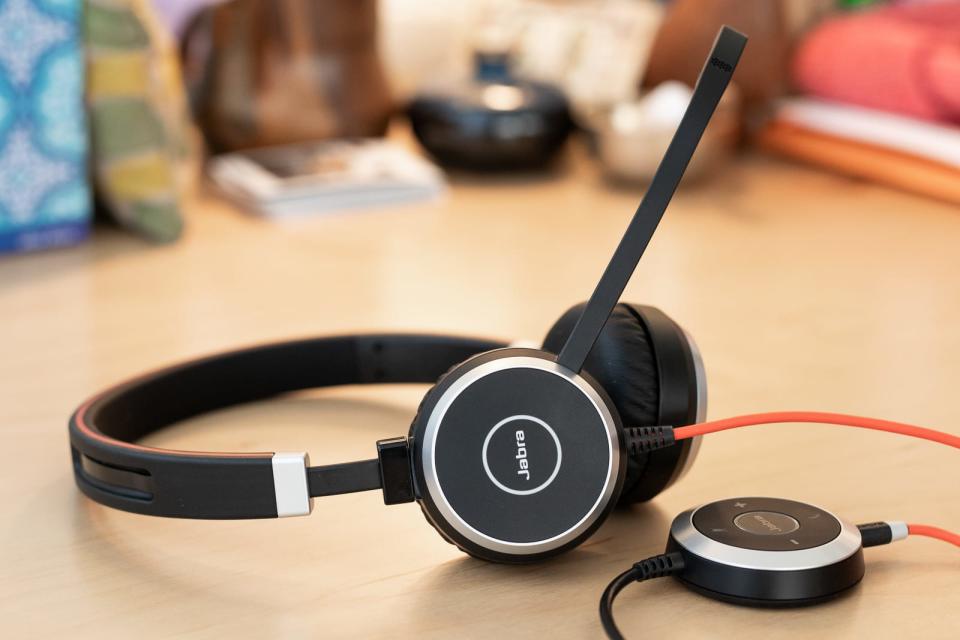
The Jabra Evolve 40 is the best USB headset for people who take a lot of calls at their computer. Due to its light weight and well-designed headband and ear pads, it's the only headset we tested that was comfortable enough to wear for an entire work day. Its boom microphone collects sound as well as any microphone we tested, and its headphones sound good for both voice and music.
The Evolve 40 is comfortable enough to wear continuously while switching between calls and other tasks, thanks to its construction and design. The entire headset is light, and its wide headband is easily adjustable. The ear pads are soft, plush, and not covered in a scratchy fabric like those on many of the other headsets we tested.
The Evolve 40 was also the the clear standout in our sound-quality evaluations. Once we figured out how to position the microphone (which rotates 270 degrees so that you can position it for left-side or right-side use), it picked up crystal-clear audio without broadcasting regular breathing sounds or ambient noise. Our test mixture of music, stand-up comedy recordings, and conference calls all sounded good through the Evolve, not tinny or distorted like it did on some models. No other headset sounded as good without compromises in other areas.
The Evolve 40 has one of the better inline controllers on the headsets we considered. The buttons are arranged simply, located at four equidistant points around the edges to form a kind of compass rose. Other controllers have buttons placed closer together, making it harder to find the exact button you want without taking your eyes off your screen. When you press the mute button (at the "north"), it turns red and an ascending-beep tone plays through the headphones to indicate that the mic is muted; press it again and the light turns off and a descending tone plays. The volume controls are on the east and west points; the south button can be used to activate a call, but only with some third-party software (you can use Jabra's compatibility guide to see if your software is supported). The button in the center is a busy indicator, which also works only with some software.
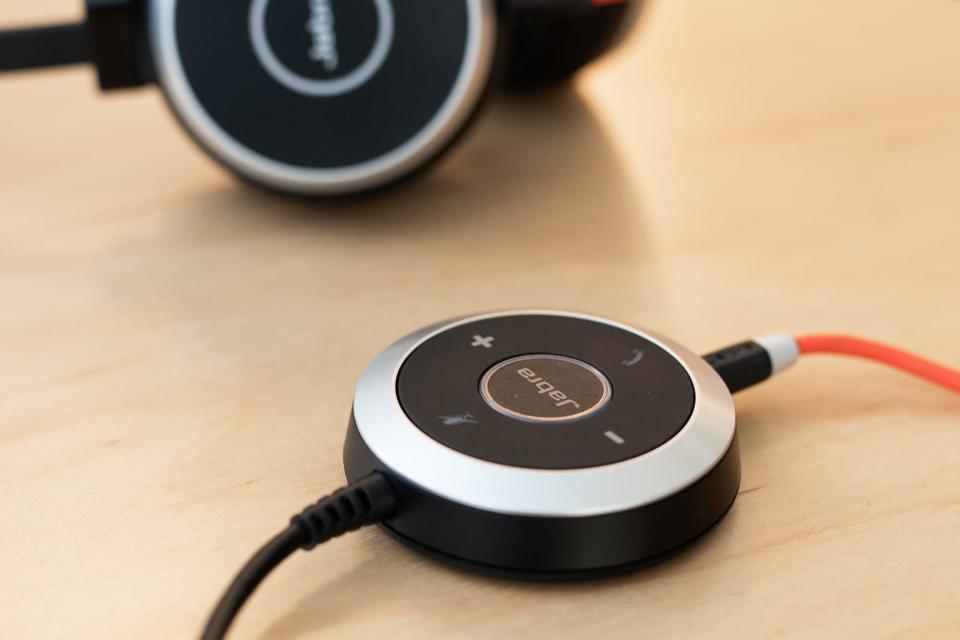
The remote also has a slight grip on the bottom to keep it from moving around much once you set it on your desk. And if you want to use the Evolve 40 with your smartphone rather than through your computer's USB-A port, you can unplug the headset's 3.5 mm plug from the remote and plug it directly into the headphone jack (assuming your phone still has one).
Flaws but not dealbreakers
We don't love the Evolve 40's mic boom. Though it's nice to be able to choose on which side of your head the mic should be, we found it a bit difficult to find the best position for the mic to maximize vocal clarity and minimize pops and breathing. We've seen a few reviews on Amazon that mention people's frustration with finding this balance, one indicating that the mic's noise-reduction feature was blocking their voice—when they moved the mic away from their mouth to reduce breathing sounds, the Evolve 40 seemed to consider their voice "ambient sound." We were able to adjust the boom to prevent this (by positioning it as far away from our nostrils as we could, while still being close to our lips), but it took a little bit of trial and error.
Budget pick: Microsoft LifeChat LX-6000
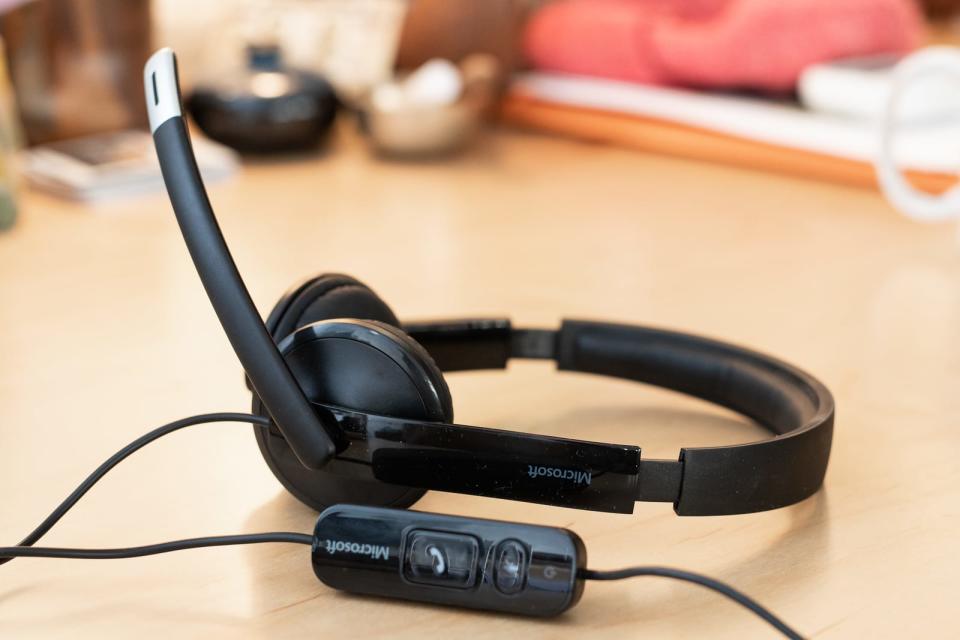
The Microsoft LifeChat LX-6000 has been a pick of ours in some form or another for years, and for good reason—it's a really solid headset. Though its microphone and headphones are not as good as those on the Jabra Evolve 40, they're competitive with some headsets we tested that cost twice as much. But unlike our top pick, the LX-6000 isn't comfortable: The design of its ear pads make the LifeChat painful to wear for anything longer than a 30-minute meeting. If you want a headset you could easily wear all day, our top pick is worth its price premium. If you just need something to wear for the occasional call, the LifeChat will do the trick.

The LifeChat's sound quality is good, but not excellent. Vocals played through its headphones and transmitted from its microphone sounded clear and full in our testing, but not as crisp as those from our top pick. Despite its inflexible boom, it's easy to position the LifeChat's microphone in a place where it doesn't transmit normal breathing sounds. But because of its small ear pads and relatively short headband, we couldn't comfortably wear the headset for much more than half and hour at a time—the pinching against our head was too painful.
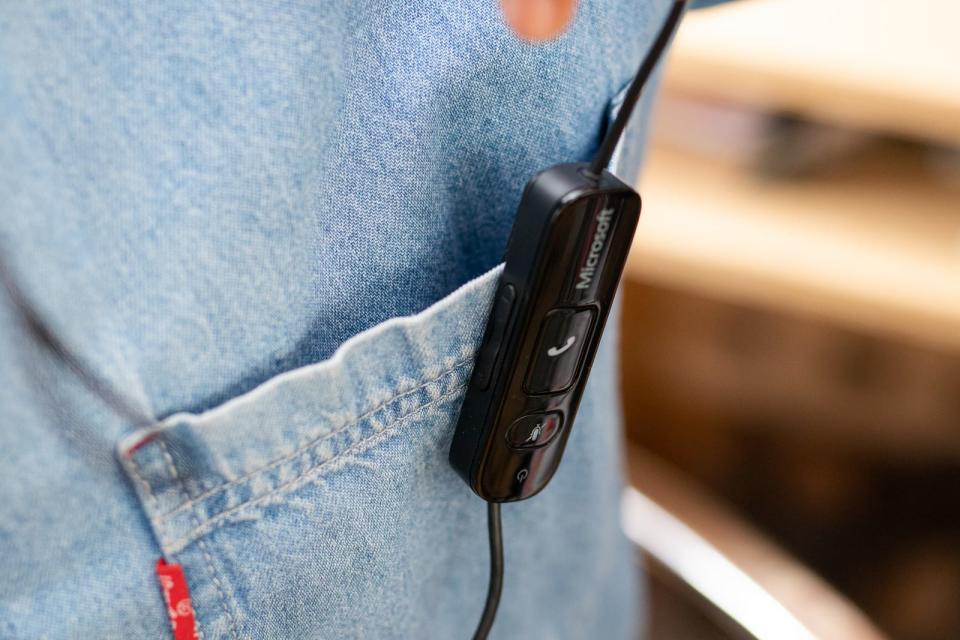
We also didn't like the headset's inline remote, which, in addition to being designed to be clipped to your clothes instead of left on a desk where it's easier to reach while typing, has a tiny mute button, an even tinier rocker volume switch, and buttons laid out on different sides. The layout of the Evolve 40's remote is much easier to use.
The competition
The Andrea NC-185 VM USB looked promising, with an aggregate Amazon rating of 4.3, but this headset sounded tinny compared to our picks, and a slight hum was present in the background during our testing.
The iMicro IM320's terrible sound quality and annoying background buzz had us quickly tossing this headset aside for any of the others, which are all significantly better options.
The Jabra Biz 1500 has a surprisingly great microphone. Unfortunately, the speaker quality is abysmal, the headset is very uncomfortable to wear, and the inline mute button feels flimsy and unresponsive.
The Jabra Evolve 20 is a lower-end version of our top pick. It has decent sounding headphones and a good inline remote, and it is pretty comfortable. But it has a worse-sounding microphone than the similarly priced Microsoft LifeChat LX-6000. We think most people looking for something to use occasionally will want the better microphone of the LifeChat.
The Jabra UC Voice 150 Duo is a less-expensive sibling of our previous main pick. Audio has a slight-but-noticeable background hiss, and incoming voices are lightly muffled.
We liked the Jabra UC Voice 550 Duo's sound quality, comfortable design, and hyper-adjustable mic boom enough to make it a previous top pick, but it's since been discontinued. It's still a good headset if you can find it.
The Logitech H390 has mediocre sound quality and occasional significant background hum.
The Logitech H540 is on the bulky side, so it's less comfortable for longer sessions. In our testing, it also had an intermittent background noise that was distracting, and muting and unmuting the microphone produces ticks that are audible to callers.
The Microsoft LifeChat LX-2000 had few professional reviews and mediocre user reviews at a similar price as the LX-3000.
The Microsoft LifeChat LX-3000's flexible boom allows for precise placement of the mic, but the bulkiness of the headset, coupled with the overall muffled sound of voices, kept it out of the running.
The Plantronics Audio 648 offers decent sound quality and noise reduction, but its behind-the-head design puts pressure on the ears and gets uncomfortable after moderate stretches of use.
The Plantronics Blackwire 725, a previous upgrade pick, offers several Windows-exclusive features that we've since determined most people will not need at a price that's simply too high.
The Plantronics Blackwire 5200 was almost our top pick based on its excellent speaker quality, plush ear pads, and well designed inline remote. Unfortunately, its microphone performed poorly; one person on the other end of a call remarked that it sounded like we were in a wind tunnel.
The Sennheiser PC 36 is comfortable and has good sound quality. Its downfall is the mechanical mute switch on the inline control, which causes a loud "thump" whenever it's toggled on or off.
The Sennheiser SC 60 USB ML is light and comfortable to wear, but its audio has a light background hiss that's distracting, and incoming callers sound slightly muffled.
The Sennheiser SC 75 has an excellent microphone and inline mute button, but its speaker quality is middling, and scratchy ear pads make it uncomfortable to wear.
This guide may have been updated by Wirecutter. To see the current recommendation, please go here.
When readers choose to buy Wirecutter's independently chosen editorial picks, Wirecutter and Engadget may earn affiliate commissions.
